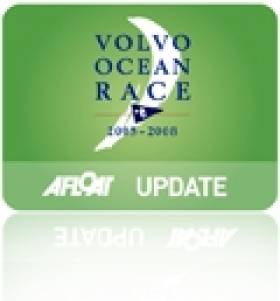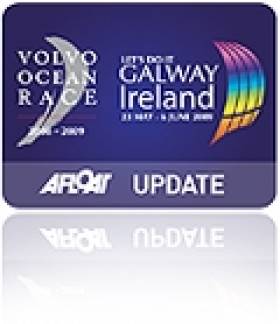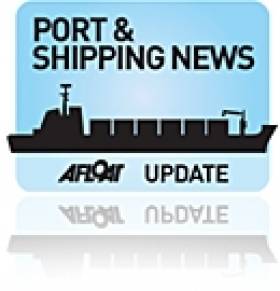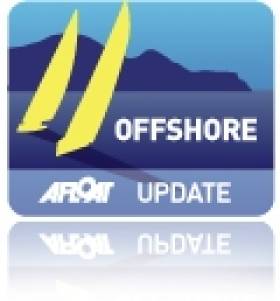Displaying items by tag: Mediterranean
Four Bodies Recovered In Greek Ferry Fire As Rescuers Battle Elements
#NormanAtlantic - RTÉ News reports that Italy has launched a criminal investigation into the blaze on the car ferry Norman Atlantic as the Greek government confirms the recovery of four bodies from the site of the disaster off Corfu.
As reported yesterday on Afloat.ie, the ferry sailing the Mediterranean from Greece to Italy called for help after a fire broke out in its lower decks.
Prosecutors will determine whether negligence played a role in the incident as rescue teams continue to battle the elements to evacuate more than 100 passengers who remain on the vessel.
The Guardian says four British nationals are among those rescued so far.
Meanwhile, according to The Irish Times, language difficulties between the crew of the Italian-registered ferry and its predominantly Greek passengers have posed problems on board.
Mediterranean Ferry With 466 Passengers 'Evacuated' After Fire
#Rescue - Some 466 people were being evacuated this morning from a car ferry that reported a fire on board while sailing from Greece to Italy this morning, according to RTÉ News.
As of 8am this morning Irish time, 130 people had been moved from the Norman Atlantic via a rescue boat to a nearby container ship some 44 nautical miles west of Corfu.
Passengers have described a lack of co-ordination in the evacuation effort since the fire broke out at 4am Irish time.
"They tried to lower some boats, but not all of us could get in," one person claiming to be a passenger told a Greek TV station by phone.
And as The Irish Times reports, poor weather in the area - with wind speeds of up to 88km per hour - has made the rescue effort "complicated".
“We are doing everything we can to save those on board and no one, no one will be left helpless in this tough situation,” said Greek shipping minister Miltiadis Varvitsiotis.
The incident comes almost three years after the wrecking of the Costa Concordia in the waters off western Italy.
RTÉ News has more on this developing story HERE.
Abu Dhabi Team Suffer Broken Mast Six Hours Into VOR
#VOLVO OCEAN RACE - Abu Dhabi Ocean Racing's challenge was nearly scuppered at the outset when their yacht suffered a broken mast just hours into the first leg of the Volvo Ocean Race yesterday. Dismast photos by Paul Todd below.
The accident occurred 30 nautical miles south of Cartagena on the Spanish Mediterranean, when the yacht Azzam encountered rough weather some six hours after leaving Alicante.
"Our mast broke into three pieces when landing off a big wave in 30+ knots of wind," said skipper Ian Walker. "We were sailing under a J4 and two reefs. We do not as yet know the cause."

A first leg disaster for Ian Walker on Abu Dhabi - Photo: Paul Todd
The broken mast pieces and rig were recovered, thanks to the "courageous" intervention of crewman Wade Morgan, who entered the water to cut away the top of the mainsail.
Walker added: “The mast from the first spreader up is now secured to the port side of the boat. About three or four metres protrude from behind the boat. A spider web of lines is keeping the operation intact. The crew are deeply disappointed.”
Yacht and crew - which includes Wexford man Justin Slattery - were last night headed towards the flatter water at Cabo de Palos before returning to Alicante under motor to begin repairs and get back in the race.
Abu Dhabi Ocean Racing are one of six teams competing in the epic round-the-world yacht race, which is set to finish in Galway next July.
Earlier this week the team finished first in the initial in-port race of the competition.
The official Volvo Ocean Race website has more on the story HERE.
Galway's 2012 VOR Stopover Will Be 'Bigger and Better'
#VOLVO OCEAN RACE - Organisers for next year's Volvo Ocean Race stopover in Galway have promised the event will be "bigger and better" than the previous race visit in 2009.
John Killeen, president of Let's Do It Galway, told the Galway Independent that he expects as many as 8,000 foreign visitors to the City of the Tribes next July.

Green Dragon on show in Alicante this week – her dockside poster reads: 'the race begins in Alicante, the party starts in Galway'
Killeen is in Alicante on the Spanish Mediterranean for the week of events and in-port races leading up to the official start of the 2011-12 Volvo Ocean Race this Saturday.
The race is set to finish in Galway on Tuesday 3 July 2012, attracting the world's media to Ireland's fifth largest city for the final prize-giving.
Nimmo's Pier will be the focus of entertainment facilities for the many thousands expected to throng the city as the six competing yachts complete their epic challenge.
"It’s a rare opportunity for Galway and Ireland to have the leverage of such an event and, if we don’t [use it to benefit Galway], it will be remissible,” said Killeen.
The Galway Independent has more on the story HERE.
Cruising Association Plans Mediterranean Sailing Seminar
Every year, at the Cruising Association's London headquarters in Limehouse, it holds a one-day seminar for those planning to cruise in the Mediterranean. Open to both members and non-members, this year's event was a sell-out with more than 90 cruising sailors taking part. To cater for the growing demand for this type of event, the Med Section is considering running two seminars a year, with a second at another venue, in late autumn.
At this year's seminar, experts from the Cruising Association's membership led sessions on:
Eco-friendly cruising: avoiding anchoring damage, reducing and recycling waste, minimising harm from grey and black water discharges, which paints and cleaners to use on hulls and decks, and preventing pollution from engines.
Albania: a new cruising destination; ports of entry, paperwork, personal security, chart accuracy, safe anchorages, restricted areas, marinas – few and small at the moment.
Healthcare: insurance, the European healthcare scheme, prescription and over-the-counter drugs, European names for UK drugs, first-aid box contents, on-board injuries, gastric problems, sunburn, dehydration, heat stroke, insects, jelly fish, and more.
Weather: typical weather patterns, national forecasts, internet forecasts, different weather models, GRIBs, Navtex, how to interpret and evaluate forecasts, forecasting from your own observations.
Regulations: boat papers, radio licences, insurance, crew lists, passports and visas, International Certificate of Competence, CEVNI, VAT, pollution control, residency, personal taxation.
Fitting-out: awnings and biminis, drinking water, swimming, scuba and snorkels, gas, refrigeration, wind and solar generation, anchoring – rodes, scope and anchor types, bow-to and stern-to mooring, tenders, passerelles, tools and spares.
At the end of the day, delegates were asked to suggest their own tactics and techniques to improve Mediterranean cruising. Many of these involved alcohol, but the prize for the best suggestion was to anchor from the stern, to encourage airflow through the boat.
Each year, the Med Section publishes a summary of members' cruising plans to make it easier for members to arrange to meet up during the summer. The Section is organising a rally on the island of Uglyan in Croatia in June this year, and a rally in the Peloponnese is planned for 2012.
Membership of the Med Section is free to any member of the Cruising Association.
Inspection of Refloated Ship in Galway Bay Under Way
Marine surveyors are currently inspecting the German cargo ship which was refloated yesterday in Galway Bay after running aground early on Thursday.
The Irish Coast Guard confirmed to The Irish Times that no pollution had occurred in the grounding of the Pantanal on the south Connemara coast.
The 120m vessel was refloated at high tide yesterday morning with help from the Celtic Isle tug from Foynes in Co Limerick.
Ship managers Harren & Partner said the hull would undergo a diver inspection before the vessel sails for dry dock.
Yesterday Minister for the Marine Simon Coveney welcomed the "successful operation in very challenging conditions" and confirmed a thorough investigation of the incident by the Marine Casualty Investigation Board.
The ship had been sailing from the Mediterranean to Rossaveal to collect two monohull ferries, sold to Mauritius, that had been built to serve the Aran Islands route.
The Irish Times has more on the story HERE.
Cruising Association's MedNet Goes Global
The Cruising Association has just launched a new internet and email based net, which lets members cruising various regions of the world arrange meets, ask questions and receive answers about ever-changing local facilities and regulations.
It all started in 2000 as Mednet, a service for some 85 members cruising yachts and motorboats in the Mediterranean. MedNet 1 allowed one-to-one email communication but soon members wanted more, especially the ability to see the answers to other members' questions.
So MedNet 2 was born in Spring 2001, providing wider access to conversations. By Autumn 2003 MedNet 2 had moved to Yahoo Groups, but as membership increased mail traffic became too heavy for slow and expensive internet connections on boats. As a consequence MedNetLite was introduced for those with low bandwidth connections. By now 250 users were exchanging news about lay-up sites, marinas, restaurants, anchorages, provisioning, boatyards, itineraries and regulatory changes. But a good long-term record of all this data was missing.
So MedNet 3 was introduced in 2006, working as an email based forum within MyCA, the Cruising Association members-only intranet. There were still shortcomings. The system was passive, collecting e-mails and displaying them online. Inputs were only by email. By now, users had grown to 350, 10% of the Cruising Association's membership. Members cruising in other regions began asking for their own networks.
The time had come to upgrade so Version 4 was developed by a group of Cruising Association members with IT skills. This has just been launched for four regions; Mediterranean, Baltic, European Inland Waterways and 'Blue Water'. Members can join as many as they wish. They post and respond online, or by email. They can receive full or lite email messages or opt for no email, just tuning in online when they have Internet access. A full record of all these discussions is maintained online, making it easy to research topics and keep the Cruising Association's many members-only publications right up-to-date.
On MedNet recent discussions have included:
• The need for grey water holding tanks in Turkey
• The cheapest way of making cash withdrawals
• Marina costs in western Italy
• Recommendations for a rigger in Preveza
• How to watch British TV in the Med
• Places for winter storage ashore
It will be interesting to see the sorts of topics that the wider use of MedNet technology brings!
Middle Sea Race Starts on Saturday
Flying into Malta it's hard not to be struck by the landscape: the buildings all a blinding beige in the hot sun, the landscape fairly arid and dry. It's more reminiscent of the Northern African coast, which is only 155 nautical miles west. The island archipelago is at the crossroads of the Mediterranean situated, as it is, midway between Sicily and the coast of Tunisia. This year's fleet reflects that more than any year past, with numerous entries from throughout Europe, Russia, the United Kingdom and the United States.
One Irish boat, Legally Brunette, from Dun Laoghaire is entered in to the race.
This 31st edition of the 606-nautical mile Rolex Middle Sea Race begins this Saturday, 23 October from Grand Harbour. Registration closes on Friday, but by press time there were 83 boats entered from 18 countries. Included in this number and back to defend, are 2009 Overall Winner, Andres Soriano on the 21-metre mini-maxi Alegre (GBR), and Line Honours winner, Mike Slade on the 30.5-metre ICAP Leopard (GBR).
The race is organized and hosted by the Royal Malta Yacht Club, which moved into stylish brand new quarters overlooking Marsamxett Harbour, just prior to last year's race. The yacht club, with as rich and varied a history as this island republic, is one of the most hospitable anywhere and provides all sailors who make the effort to trek here, a warm welcome.
Yesterday, a low pressure system that swept through south of Sicily, with winds of 50 knots and 3 to 4 metre seas, which has delayed the arrival of some of the foreign fleet. Though some like Esimit Europa 2 (SLO) and Wild Joe (HUN) were already committed to crossing and so endured the conditions encountered enroute. The 30-metre Esimit had a lightening strike that took out the wind instruments at the top of its 44-metre mast. Meanwhile, Marton Jozsa's Wild Joe, a R/P Custom 60, which set out from Croatia on Friday, and then from Sicily yesterday morning, had a tough crossing, ripping both their mainsail and jib.
Many of the fleet is moored in Camper & Nicholson's Grand Harbour Marina and dockside there today there was a flurry of activity with crews effecting repairs or otherwise prepping for Saturday's offshore race. Tomorrow, Wednesday, there will be Coastal Race most likely around neighboring Comino Island. Some boats, though not all, use this race as a tune-up for the offshore.
Along the quay, there were country flags on the back of boats from Spain, Italy, Hungary, Slovenia, the UK and United States, as well as a local fleet of competitors from Malta. One would think the Maltese might have an edge – local knowledge of the area, perhaps – and in that group one of the ringers may well be Jaru (MLT), a J/133 co-skippered by John Ripard Jr. and his brother-in-law, Andrew Calascione. The close relations don't stop there, as half the crew are composed of their children, with a few close friends from the UK there to round out the crew.
Sailing onboard, as helmsman and watch leader, is 23-year old, Sebastian Ripard. This youngest of the Ripard generation is taking time out from his, and team mate Benji Borg's, campaign in the 49er class for the 2012/2016 Olympics. This 600+ mile race requires switching gears from 'around the cans'. Asked what he likes about this, his eighth, race, Sebastian said, "It's a beautiful race. I mean one of the marks is a volcano, which is often erupting! There's always a bit of everything in this race, tactically there are a lot of different points where the race compresses, so there's a lot of tricky areas: the Straits (of Messina), Stromboli, by Favignana, which make it challenging throughout. There are a lot of variables that keep on changing. And I quite enjoy the mental demands of an offshore race; it's more of an adventure. In his first go round in 2002, he racked up an overall win on the J/109 Jammin' (MLT) with – same as this year – his father and uncle. He followed that with a 2nd place in the J/109 Artie (MLT) with Lee Sartariano.
The J-Boat has a good track record for the race: a J/133 won its' class and placed 2nd overall in the 2008 Rolex Middle Sea Race. The 43-footer was Sailing World magazines' "Boat of the Year" award when it was launched in 2003 and the design has proven itself for performance cruising and offshore racing.
Almost all foreign competitors seem drawn to this unique race: a long offshore, anti-clockwise around Sicily, a few volcanoes, and some neighboring islands. Bryon Ehrhart owner and skipper of Lucky (USA), is one of those. Ehrhart, from Chicago, first raced the boat in the 2006 Newport Bermuda Race. Since then they have competed in the 2007 Transpac Race, the 2008 Chicago Mackinac, and the 2009 Rolex Fastnet Race.
His crew are a group of strong amateurs, with a few professionals that have sailed together for years. For the most part, they are Etchells (one-design) sailors, and plan to bring that level of intensity and competitiveness from the small boat fleet to a big boat offshore program.
Ehrhart said, "We have an interest in doing the truly great ocean races and certainly the Rolex Middle Sea Race is one of them. It's a race that I have read about over the years and have thought that – because of the course – would be strategically and tactically challenging, maybe even the most challenging we have done or will ever do.
"A fantastic amount of preparation has gone into getting the boat ready for this race and we hope we are up to all that we may encounter. We have converted this TP52 to an IRC offshore boat. We do a couple of big events a year and this race is the only offshore event we are doing in 2010: it is a race of the quality that is worth organizing our year around. "
Thursday is a Crew Party at the Royal Malta Yacht Club, and on Friday there will be Skipper's race and weather briefing. The Rolex Middle Sea Race commences on Saturday, 23 October 2010. The final prize giving is on Saturday, 30 October. George David's Rambler (USA) established the current Course Record of 47 hours, 55 minutes, and 3 seconds in 2007.






























